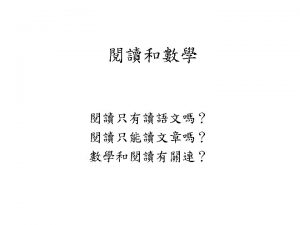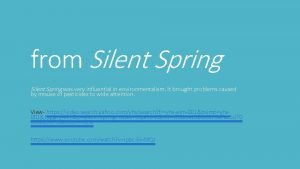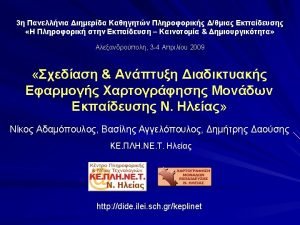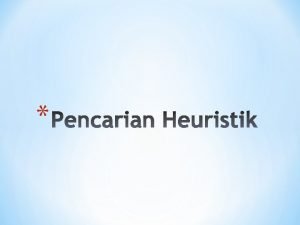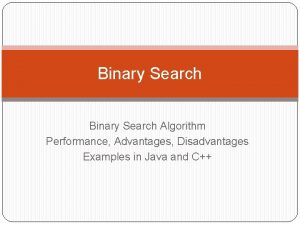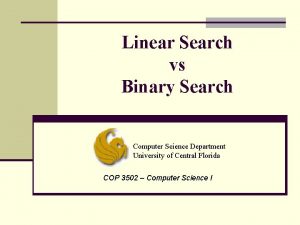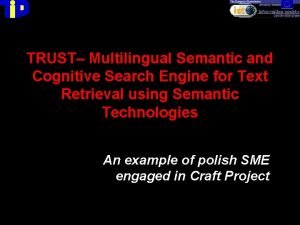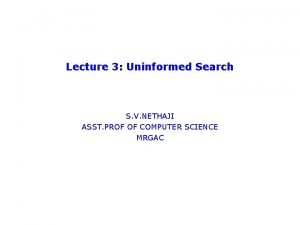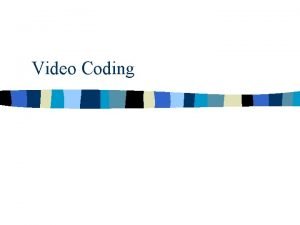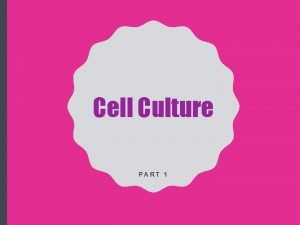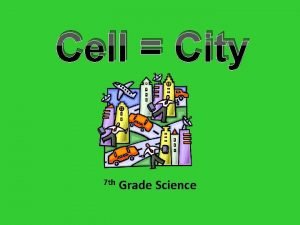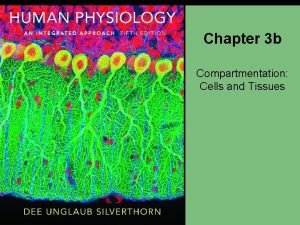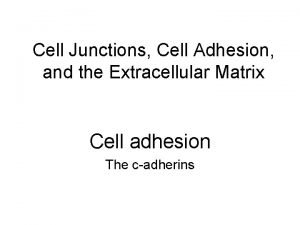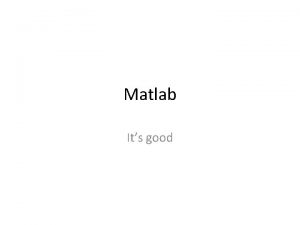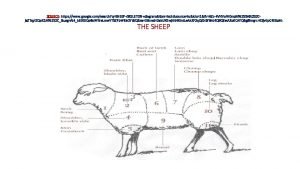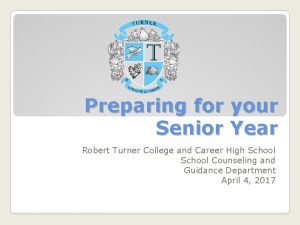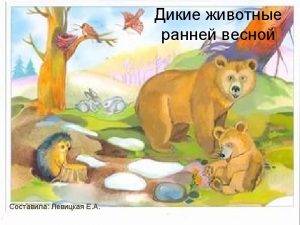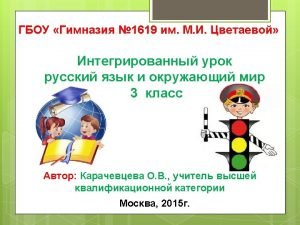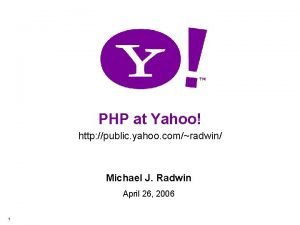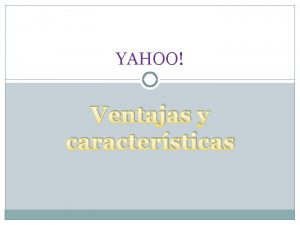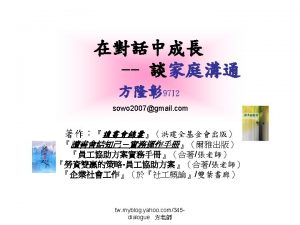UNIT 3 CELL Video https video search yahoo






























































- Slides: 62

UNIT 3 CELL Video : https: //video. search. yahoo. com/yhs/search? fr=yhs-sz-001&hsimp=yhs 001&hspart=sz&p=video+on+cell+parts+and+functions#id=16&vid=79 c 9732 ff 87 af 835102 d 2 f 668261 cb 28&acti on=view • Cell theory • Types of cells (prokaryotic vs eukaryotic and plant vsanimal) • Homeostasis in cells • Enzymes • Biomolecules • Cell structure and function and processes • Transport across cellular membranes • Overview of photosynthesis • Cellular respiration and ATP • Cell cycle, mitosis, and cancer

CELL THEORY‐pp 70‐ 71. HMH, pp 190‐ 192 Red EQ: What are the 3 facts of the cell theory-? (Pigs Are Bacon) • http: //www. youtube. com/watch? v=dsc. Y_2 QQb. KU 1. All living organisms are made up of cells 2. The cell =basic unit of life 3. All new cells come from preexisting cells Before the acceptance of this third fact, scientists used to believe that cells came from non-living things-a concept called spontaneous generation ------------------------------------------------------------------------------------- • Scientists connected to cell discovery - These scientists did continuous testing and investigating put the cell theory together THE INVENTION OF THE LIGHT COMPOUND *Robert Hooke-discovered cells. Hooke used a light compound MICROSCOPE ALLOWED SCIENTISTS TO STUDY THE CELL microscope to examine the cells IN MORE DETAILS *Leeuwenhoek-Observed living cells with better microscopes *Schleiden-discovered that plants have cells *Schwan-Noted that All living things are made up of cells *Virchow-proposed that all cells came from other cells Review from Unit 1 THEORY-(PECW) A scientific theory allows for predictions, (P) A theory allows us to make explanations(E) A theory is changeable, -a new discovery ex. new disease, microscope an change a theory( C) A theory came from a well tested Hypothesisthat has been tested many times and results were similar (W)

Light and Electron Microscope. Pp 23‐ 24 Blue HMH THE INVENTION OF THE LIGHT COMPOUND MICROSCOPE ALLOWED SCIENTISTS TO STUDY THE CELL IN MORE DETAILS Light –Compound Microscope: * Uses light * Maximum magnification 1000 -2000 times. * Image is colored *Living specimen can be viewed * can be used to see cell parts pp 191‐ 192 Red Electron Microscope: - Uses electrons, . - Maximum magnification 1, 600, 000 to 2, 500, 000 times; greater magnification than light m. scope - Image is black and white. -Cell structures as small as 1 billionth of a meter -Specimen must be dead or preserved -can see small cell parts, & tiny bacteria & smaller specimens that in light m. scope Electron M/scopes Transmission + Scanning Transmission Electron‐ need thin samples; images are flat & 2 Dimensional, can explore large protein molecules To find the magnification of an object multiply Y (eyepiece ) by Z (objective) Scanning Electron‐samples can be any thickness and you can obtain 3 dimensional images -TEMIT

PROKARYOTIC (P)AND EUKARYOTIC (E) (CELLS) pp 72 HMH blue. pp 193‐ 4 Acronym=NUMBER (NU‐nucleus, MB‐membrane bound, ER=eukaryotic • In Eukaryotic cells (E), there is a nucleus with the DNA. In Prokaryotic cells (P) there is NO nucleus the so DNA scattered In E‐Cells, ‐ parts are membrane bound ex. nuclear membrane surrounds the nucleus. In P cells ‐parts are not bound by membranes • E‐Larger, more complex, Prokaryotic cells are smaller and simpler, • *P cells have a cell wall, cell membrane + ribosomes, Similarities= P+E have ribosomes, P+E have cell membranes + cell wall if it is A plant cell • ACRONYM=NUMBER • (nucleus+membrane bound=eukaroytes)


What are the Differences p. 74 HMH Blue. pp 207 Red between PLANT & ANIMAL CELLS 1 2 3 Large central vacuole 4

Now, After studying Slides 2 thru 6 • DO Multiple choice 1 -20 • DO NOWs 1. Suppose you discovered a new type of plant, applying the cell theory, what can you say for certain -about the organism? Sl. 2) 2. List the ways you can determine that a cell is plant cell and not an animal cell. (Sl. 6) 3. You are doing work in a lab but need to work with a living specimen. What the best choice of microscope? (Slide 3) 4. Using your acronym NUMBER-list the features you will find in a Eukaryotic cell that are not found in a prokaryotic. (Slides 4, 5)

DIAGRAMS OF PLANT AND ANIMAL CELLS (printout) DIAGRAMS OF PLANT AND ANIMAL CELLS 1. LABEL one cell as PLANT CELL + the other as ANIMAL CELL. HMH Blue 74 p 206‐ 207 Red 2. NAME EACH PART in both cells 3. STATE THE FUNCTION(work) OF EACH PART‐using a verb + noun (<5 words) Slide 9+207 Red 4. State the name of process that each part is involved in (“ion “ or “is” words) 5. STATE THE PRODUCT‐ associated with each part/process For example-Mitochondria-makes energy, cellular respiration, energy stored as ATP.

CELL STRUCTURE-CHART w. CELL ORGANELLES, PROCESSES, PRODUCTS pp 206 -207 Red Name of Cell Organelle or structure EX. Mitochondria (mitochondrium (one) Cell Membrane Cell Wall Chloroplast Nucleus Nucleolus Nuclear membrane/Envelope Nuclear Pores Chromosome +Chromatin Cytoplasm Cytoskeleton cell part or Function Use important Verb + Nouns ( 5 -6 words) Process= Product associated with the organelle Makes & stores ATP energy Process=Cellular respiration Glucose is converted to ATP energy printout

CELL STRUCTURE-CHART w. CELL ORGANELLES, PROCESSES, PRODUCTS pp 206 -207 Red Continued Cilia/ Flagella Microtubule Microfilament Ribosome Endoplasmic Reticulum Rough + Smooth Golgi Apparatus/bodies Lysosome Vacuole-Food + water Centrioles/ Basal bodies Processes include- (usually the processes end with “IS” or “ION”) OSMOSIS, DIFFUSION, FACILITATED TRANSPORT- transport of water + materials in cell. CELLULAR RESPIRATION- makes + stores ATP energy (energy reaction) PHOTOSYNTHESIS -Plants use sunlight to make chemical energy glucose (energy Reaction) PROTEIN SYNTHESIS= joins amino acids. This includes i. Protein assembly ii. protein transport iii. protein modification, sorting+ packaging CELL DIVISION-Mitosis & Meiosos SUPPORT=Helps to strengthen + keep shape of cell STORAGE- Keeps food and/or water CLEANUP=Repair, breakdown of cell parts printout

CELL PARTS + FUNCTIONS Also Look at Slide 13 *Chromosomes‐ Contains DNA, for cell Division Centrioles-Takes part in cell division *Lysosomes‐have membranes + enzymes They cause lysis or break down of cell parts like old worn out parts as well as macromolecules *Microtubles‐ support, cell shape cell division *Microfilaments‐ Support, movement in cell Cilia +flagella‐movement Cytoskeleton-support, shape, protection

ANIMAL CELL PLANT CELL

PARTS & FUNCTIONS OF THE NUCLEUS of the CELL pp 75 Blue. Red Bk. p 197 REMEMBER ONLY EUKAROYTES HAVE A NUCLEUS w. HICH HAS THE DNA !! envelope In prokaroytesthe DNA is scattered in the cytoplasm. . there is NO nucleus !!

PROTEIN SYNTHESIS. Red p. 200‐ 201. HMH Blue p. 76 Protein synthesis consists of 1. assembly in ribosomes. 2. exporting to ER. 3. packaging in golgi bodies. https: //video. search. yahoo. com/yhs/search? fr=yhs‐sz‐ 001&hsimp=yhs‐ 001&hspart=sz&p=video+protein+synthesis+ribosomes+ER+golgi#id=2&vid=7 f 143 e 102 d 1 d 54 bb 094 c 887 a 1 ea 4 c 75 f&action=click 1. RIBOSOMES ( R)‐Red p. 200. HMH. p. 76 *Ribosomes –take amino acids + join them up into proteins. *This means R make/synthesize or assemble proteins by joining up amino acids, the monomers of proteins. R is site of Protein Syn *Ribosome get their coding from DNA which makes RNA. The RNA moves from the nucleus to the ribosomes which are embedded in the cytoplasm. *R can then become attached to ER or may be suspended in the cytoplasm. *REMEMBER‐BOTH prokaryotes +Eukaryotes have ribosomes 2. ENDOPLASMIC RECTICULUM (ER)- Red p. 200. HMH 76 *ER is a network of folded membranes. *ER is where proteins made in the ribosomes are exported and become attached. *ER is where lipids are also assembled *If the ER has ribosomes it is called the ROUGH ER. *Some parts of the Endoplasmic Reticulum have NO ribosomes and are called SMOOTH ER 3. GOLGI BODIES/APPARATUS‐ Red p. 201 HMH p. 76 *Golgi Bodies are stacks of membranes *In Eukaryotic ells, proteins move from the rough ER to Golgi *Golgi Modifies, sorts and packages the proteins. *From the Golgi bodies/apparatus‐proteins travel in sacs called vesicles to wherever they are needed in the cell See expanded diagrams on next slide 1 2 3 4

PROTEIN SYNTHESIS‐involves the team work of ‐: 1. Ribosomes 2. Endoplasmic Reticulum Red p. 200‐ 201. HMH Blue p. 76, Slide 14 3. Golgi Bodies/Apparatus https: //video. search. yahoo. com/yhs/search? fr=yhs‐sz‐ 001&hsimp=yhs 001&hspart=sz&p=video+protein+synthesis+ribosomes+ER+golgi#id=2&vid=7 f 143 e 102 d 1 d 54 bb 094 c 887 a 1 ea 4 c 75 f&action=click 1 1. 2 3 4 INO AM AC ID 2

Now Do Nows. 5, 6, 7, 8. DO NOWs Red p. 200 -201 Then MC 21 -30 p 76 HMH Blue Study Slide 14/15 #5. In one paragraph, describe the process of protein synthesis starting from the nucleus ending with the golgi bodies. *Name and number the organelles in the proper sequence *State the function of each. Make sure you use the words-nucleus, DNA, RNA, code, amino acids, proteins, ribosomes, endoplasmic reticulum, golgi bodies, rough ER , smooth ER --------------------------------------------------------#6. Differentiate between the Rough and the smooth Endoplasmic Reticulum. --------------------------------------------------------#7. Do you think that both Prokaryotes as well as Eukaryotes carry out Protein Synthesis? Give a reason for your answer? ------------------------------------------------------------#8. Describe the structure (parts) of the nucleus and its function(Slide 13. p 75 of HMH blue book) ----------------------------------------------------------------- DO QUESTIONS 21 -30. (10 questions)

ENERGY ORGANELLES OF THE CELL ARE – 1. MITOCHONDRIA for CELL RESPIRATION+ pp 202 Red. Blue 77 2. CHLOROPLASTS for PHOTOSYNTHESIS pp 202 Red. Blue 79 Video: https: //www. youtube. com/watch? v=pk. Eql. ZUq. L 0 Y MITOCHONDRIA 1. * Mitochondria(M) (see diagram) are the sites/place for the process of cellular respiration in cells. Respiration makes ATP energy. Mitochondria stores the ATP. *Mitochondria are organelles that are made up of folded membranes *In mitochondria, cellular respiration produces ATP energy as shown in equation * Glucose + oxygen are broken down & stored as ATP energy *M are found in both plants + animals. Plants =producers =autotrophs Animals = consumers =heterotrophs. *M are found in Plants + animals because they all respire+ they all need energy to carry out their processes. 2. *Chloroplasts are the sites/place/organelle in cells for photosynthesis. *Chloroplasts are found in leaves in plants & algae ONLY. Plants=producers =autotrophs *Chloroplasts contain molecules/green pigments called chlorophyll and other pigments that trap sunlight membranes called grana. (diagram) *Grana are comprised of thylakoids or stacked membranes *In chloroplasts photosynthesis coverts solar energy to chemical energy in the form of glucose. Equation below:

Photosynthesis (PS)=Plants make food. PS has 2 stages STAGE 1 =Light dependent=needs light 1. Sunlight comes in 2. Water comes in 3. H 2 O splits into O 2 (oxygen) and H+ 4. In grana in thylakoids in chloroplast EQUATION-Photosynthesis carbon dioxide + water ==> glucose + oxygen 6 CO 2 + 6 H 2 O ------ C 6 H 12 O 6 + 6 O 2 STAGE 2 = Light independent=No light needed 1. H+ joins with a chemical called NADPH 2. Chemical called ADP picks up P ATP(energy) 3. Carbon dioxide (CO 2) comes in 4. Series of reactions occur Sugar /glucose formed 5. In stroma of chloroplast Which candle burns longer & why? FACTORS AFFECTNG Photosynthesis- and the enzymes used in PS: light intensity water CO 2 Temperatures(affect enzymes)

How are Photosynthesis & Respiration Related ppp 253 Red /pp 113 HMH Blue Video‐www. youtube. com/watch? v=B 1_ID 34 h. H 4 w The products or Outputs of photosynthesis (Glucose and Oxygen) go into respiration. So the products of PS are the reactants of Respiration The products of respiration ( CO 2 and H 2 O) are the reactants of Photosynthesis.

Do Nows on worksheet 9, 10. Then Do MC 31 -40 WORK SHEET FOR DO NOWs #9 + # 10 Study Slides 17, 19 ‐‐‐‐‐‐‐‐‐‐‐‐‐‐‐‐‐‐‐‐‐‐‐‐‐‐‐‐‐‐‐‐‐‐‐‐‐‐‐‐‐‐‐‐‐‐‐‐‐‐‐‐‐‐ #9. Do Now –on work sheet‐Differences between Photosynthesis and Respiration (pp 82 on old file) ‐‐‐‐‐‐‐‐‐‐‐‐‐‐‐‐‐‐‐‐‐‐‐‐‐‐‐‐‐‐‐‐‐‐‐‐‐‐‐‐‐‐‐‐‐‐‐‐‐‐‐‐‐‐ #10. Draw the diagram of Photosynthesis on the back. Draw the diagram of the 2 Trpes of Respiration‐AEROBIC and AEROBIC Respiration #11. On work sheet *Write a paragraph‐Explain in your own words How is Cellular respiration and photo synthesis interrelated? (Sl. 17) Talk about reactants & where the come from for the reactions Talk about the products & where they go. ‐‐‐‐‐‐‐‐‐‐‐‐‐‐‐‐‐‐‐‐‐‐‐‐‐‐‐‐‐‐‐‐‐‐‐‐‐‐‐‐‐‐‐‐‐‐‐‐‐‐‐‐‐‐ DO MC 31‐ 40. (10 questions)

What happens in CELLULAR RESPIRATION –There are 2 types‐Aerobic +Anaerobic 251+260 https: //www. youtube. com/watch? v=Tc. Mq. Vn. VG 3 Zk AEROBIC –with O 2 – pp 260 ANAEROBIC w/out O 2‐pp 263 1, Glycolysis 2. Krebs Cycle 3. Electron Transport EQUATION: CELL RESPIRATION C 6 H 12 O 6 + 6 O 2 ------> 6 CO 2 + 6 H 2 O + (energy) 36 ATP Glucose sugar +Oxygen Carbon dioxide +water+energy YOGURT ALCOHOL

RESPIRATION ‐ https: //www. youtube. com/watch? v=Tc. Mq. Vn. VG 3 Zk There are 2 types of Respiration. 1. Anaerobic (No O 2) 260 Red NO O 2 + 2. Aerobic (O 2) 260 Red with O 2 GLUCOSE six‐Carbon compound IS BROKEN DOWN into 2 –three Carbon In both processes 2 ATP ALCOHOL 2 ATP YOGURT Ex. Fungus like yeast, molds and anaerobic bacteria Ex. Most plants + animals 32 ATP EQUATION: CELL RESPIRATION C 6 H 12 O 6 + 6 O 2 ‐‐‐‐‐‐> 6 CO 2 + 6 H 2 O + (energy) 36 ATP Glucose sugar + Oxygen Carbon dioxide +water + energy

ATP Production pp 227 • What is ATP‐Adenosine Triphosphate (3 P+phosphates) which stores chemical energy for the cell to use in its activities. • ATP Production happens‐Where-In Mitochondria in Process-Cellular Respiration in all plants and animals • What Happens‐Cell takes ADP (adenonsine diphosphate(2 P+phosphates) grabs a phosphate molecule(P+) making it ATP (triphosphate‐ 3 P) that stores energy ( See diagram) *When ATP (3 P+) loses that P/phosphate it becomes ADP (2 P+) + energy from the broken bond is released for lants and animals to arryout all body functions. • ATP synthase enzyme helps the reaction • 3 types of ATP used in humans‐ ATP in the muscles ATP from lactic acid fermentation ATP from cellular respiration

DO NOW #. 12 + 13 Do. Nows #12 + #13 Do this at bottom of your printout of the Do Nows 9. 10. 11. ------------------------------------------DO NOW #12. Study Slide 22 There are 2 types of respiration. 1. Name the 2 types of respiration? 2. List the differences between the 2 types of respiration in terms of (i) O 2 (ii) ATP energy (iii) Efficiency (iv)2 examples of organisms that use each type of respiration ‐‐‐‐‐‐‐‐‐‐‐‐‐‐‐‐‐‐‐‐‐‐‐‐‐‐‐‐‐‐‐‐‐‐‐‐‐‐‐‐‐‐‐‐‐‐‐ DO NOW #13. Read and study Slide 23 *Explain how the energy stored in ATP or Adenosine Triphosphate is released to be used ib the cell’s activities? ‐‐‐‐‐‐‐‐‐‐‐‐‐‐‐‐‐‐‐‐‐‐‐‐‐‐‐‐‐‐‐‐‐‐‐‐‐‐‐‐‐‐‐‐‐‐‐ DO MC 41‐ 50

OTHER ORGANELLES NOT STUDIED BEFORE 1 3 2 4 CILIA and FLAGELLA 5

CELL PARTS + FUNCTIONS *Chromosomes‐ Contains DNA, for cell Division *Centrioles-Takes part in cell division *Lysosomes‐have membranes + enzymes They cause lysis or break down of cell parts like old worn out parts as well as macromolecules *Microtubles‐ support, cell shape cell division *Microfilaments‐ Support, movement in cell Cilia +flagella‐movement Cytoskeleton-support, shape, protection AN PLANT CELL IM AL CE LL

• NOW, STUDY SLIDES #25 and REVIEW SLIDE #26 • ANSWER THE MC questions ‐ 51‐ 60. • Look back at the chart +diagram of the cell and Complete the column on processes.

MC 1‐ 60 Stop for • THANKSGIVING Break

CONCEPT MAP ON PHOTO SYNTHESIS (PS). Use headings below, identify connections relationship to PS. Page numbers given https: //www. youtube. com/watch? v=3 p. D 68 ux. RLk. M • • • • • • • • 1. DEFINITION – pp 228 2. WHO DOES PS (Use words ex. producers, autotrophs)‐pp 228 3. IMPORTANCE TO LIFE ‐pp 77, 75 4. ORGANISMS AND ORGANS + CELLS‐pp 231, 681 and TISSUES (ppp 681) 5. ORGANELLES INVOLVED IN PS, PIGMENT incolved‐pp 230, 231 233. 6. EQUATION in English + Chemistry –REACTANTS/INPUTS, PRODUCTS/OUTPUTS‐ pp 232 7. HOW IS PS RELATED TO ORGANIC MOLECULES‐pp 46 8. CONNECT WHERE EACH REACTANT COMES FROM ‐process, cycle, chain +HOW DOES EACH REACTANT GET INTO THE PLANT‐ex. H 2 O gets in from soil‐through the roots by Osmosis water cycle. (686) 9. CONNECT WHERE EACH PRODUCT GOES –(O 2 + GLUCOSE) PROCESS OF LEAVING PLANT, THROUGH WHICH CELL DOES IT LEAVE, CYCLE, CHAINS, PYRAMID‐ pp 77, 83, 75, 10. CONNECT PRODUCT GLUCOSE AS IT GOES TO AEROBIC +ANAEROBIC RESPIRATION pp 260 +263 11. HOW DOES SUGARS MOVE THROUGH THE PLANT FROM THE LEAVES WHERE THEY ARE MADE‐pp 687 12. STAGES OF PS‐WHAT HAPPENS IN EACH STAGE of PS, WHERE IN THEE CHLOROPLAST DOE STHIS HAPPEN‐pp 233 13. FACTORS AFFECTING PHOTOSYNTHESIS‐ pp 77, 84 14. ENERGY CHANGES IN PS pp 77 15. HOW ARE ALGAE+PHYTOPLANKTONS ASSOCIATED WITH PS pp 119, pp 73 16. HOW DOES PS CHANGE AS WATER GETS DEEPER IN WATER ECOSYSTEMS pp 117, 120 (Use photic, aphotic) 17. HOW ARE ESTAURIES RELATED TO PS pp 119 18. HOW IS PS RELATED TO BROMYTHYL BLUE Checklist Did you connect PS with‐‐‐‐ Cellular Respiration Energy Pyramid Animals Water ecosystems Biogeochemical cycles Chloroplasts and its parts

• Simple diffusion (gases) • Facilitated diffusion • Osmosis (water only) • Active Transport (w. energy) • Absorption -Reactant/product, process, plant part/tissue


CELL BOUNDARIES are 1. Cell membrane 2. Cell Wall pp 203 -4 Video: https: //www. youtube. com/watch? v=J 5 p. WH 1 r 3 pg. U 1. *CELL MEMBRANE = Also called Plasma Membrane = lipid Bilayer *Where is it found- Outside of cell, like a door in animal cell; inside cell wall of plants *Function: cell membrane is semi-permeable or selectively permeable allowing some substances to pass through it and rejecting some. It controls what enters and leaves the entire cell. *Who has a cell membrane. ALL CELLS -PROKARYOTES & EUKARYOTES, PLANT +ANIMAL have a cell membrane. What is cell membrane made up of-It is made up of 2 layers of lipids bilayer +other Molecules (diagram) It is considered fluid mosaic because it has many Different kinds of molecules+is always moving. ---------------2. *CELL WALLWhere-found in plants ONLY on the outside of the cell membrane Function: maintains shape(see above dia) support and structure. What is it made up of =a carbohydrate called cellulose

MACROMOLECULES EQ: What are the main macromolecules of living organisms? EQ: Why are these macromolecules organic ? EQ: Compare the compositions and functions of these molecules? P. 45‐ 50 Red + HMH Bks CARBOHYDRATES‐ Composed of sugars or saccaharides. Monomer=monosaccharide Polymer=polysaccharide Contain C, H, O. =ORGANIC Function‐immediate source of energy LIPIDS‐Composed of fatty acids+ glycerol. Contain C. H, O. Function‐parts of membrane as in phospolipids, insulation, stores energy. NUCLEIC ACIDS‐Composed of nucleotides (which has a sugar, phosphate & base) Contains‐C, H, O, N NUCLEOTIDE Monomer=nucleotide E Polymer=Nucleic Acid Function. ‐contains genes & genetic information as in DNA +RNA PROTEINS‐ Composed of amino acids. Monomer=amino acids(which has an amino group & a carboxyl) joined by a peptide bond. Polymer=protein Contains C, H, O, N… Function: enzymes, cell structure, immunity. Muscles, cell transport, blood hemoglobin

CELL TRANSPORT across the Cell Membrane can be – pp 208‐ 210+199 Blue Video: https: //www. youtube. com/watch? v=J 5 p. WH 1 r 3 pg. U 1. PASSIVE=no energy as in 1. diffusion, 2. Osmosis, 3. facilitated diffusion 2. ACTIVE=requires energy (AAA‐triple A‐active, ATP, Against CC)) Passive Transport-For passive transport to occur there needs to be *concentration gradient (difference in number of molecules from I area to next)This provides force of movement from high to low concentration. *No energy is used. * Semi permeable membrane is needed. *membrane Proteins may be needed *Ex. 1. Simple Diffusion‐ Active Transport 2. Osmosis AAA *no concentration gradient needed. *materials can move from low to high concentration *Needs+uses energy‐ATP *Examples‐ 1. 1. Movement of chemicals, molecules 2. Bulk (endocytosis and exocytosis) 3. Facilitated Transport‐membrane protein needed 2. Endocytosis Exocytosis .

DO NOW #14 (i) Label the diagram of the cell membrane /204 Red. Slide 32 (ii) List the other names for the cell membrane (iii) State the functions of the cell membrane (iv) State the function of membrane protein (v) Explain why the cell membrane is a. “fluid mosaic” and b. “selectively permeable. ” (vi) The cell membrane is made up mainly of molecules called phospholipids. Which macromolecule does these molecules belong to. What are they made up of (Slide 33) (vii) Which organisms contain a cell membrane


Movement of Water through The Cell Membrane‐Osmosis pp 211 Red Video: https: //www. youtube. com/watch? v=IMCj 1 Fm 2 RQ 8 Osmosis FRESH WATER What happens when a cell is placed in fresh water?

EQ: How do enzymes speed up reactions? See diagram below https: //highered. mcgrawhill. com/sites/0072495855/student_view 0/chapter 2/animation__ how_enzymes_work. html How can we recognize names of enzymes? Enzymes Names end in ”ase, “ or “in” Include these following words to explain how enzyme work‐: - enzyme, protein, catalyst, , binds, substrate, enzymesubstrate complex, reactant, product, shape, active site, original, activation energy, reaction rate. S+E SE PE P + E

REVIEW ON ENZYMES *WHAT ARE ENZYMES (E) E=proteins, made up of amino acids E=biological catalysts that is they speed up reactions in all body processes E=lower activation energy required to start reactions +speed up reactions E=Enzymes names end with “ase” and “in” EQ: WHAT ARE THE FACTORS AFFECTING ENZYME ACTIVITY? 1. *Temperature 2. *PH 3. Concentration of substrate *Each enzyme has a specific temperature and ph range under which it works best or is at its optimum. beyond these ranges the enzyme is denatured or its shape is distorted and enzyme reactions begin to decrease

The Interelationship /Correlation between Photosynthesis and Respiration http: //www. youtube. com/watch? v=Kpg. ZG 9 T 0 y 34 WHAT PROCESS IS THE PLANT CARRYING OUT ? water and Bromothymol Blue BB+ Elodea plant Pts. A. Bromothyl Blue yellow when it is acidic. B. CO 2 is acidic. EQ: 1. Why does the Elodea plant in darkness turn the Bromothyol Blue Yellow 2. What will happen if a fish or another animal is added to Elodea and BB 3. What happens if the yellow solution is placed in a sunlight with the plant? Explain Bromothymol blue is an indicator which changes colour in the presence of an acid. When carbon dioxide mixes with water it produces carbonic acid (soda water). A pretty common experiment involves putting a respiring organism in water mixed with bromothymol blue, the water should turn yellow as the organism takes in oxygen and produces carbon dioxide. The indicator can be changed back to its original blue colour by removing the carbon dioxide from the water, i. e. putting in a plant to run photosynthesis - drawing out the carbon dioxide to produce oxygen http: //www. youtube. com/watch? v=fu. OMKWBDAT 0

The Interelationship /Correlation between Photosynthesis and Respirationhttp: //www. youtube. com/watch? v=Ii. Kve. Z 99 k. XY with water and Bromothymol Blue + Elodea plant with water and Bromothymol Blue +CO 2 with water and Bromothymol Blue + Elodea plant after a few hours in darkness turns bak blue. *Why does the Elodea plant turn the Bromothyol Blue Yellow * Which process is the plant carrying out? – Respiration CO 2 acidic Blue yellow

An experiment setup-elodea in a testube with a light. -- is shown in the diagram below. Which conclusions could you draw from the experimental setup? A green plants need light for cell division B plants grow best in the absence of light C green water plants release a gas in the presence of light D roots of water plants absorb minerals in the absence of light


UNIT 3 VOCABULARY-Topic: Cell 3. 1. pp 194 -200. Cell, eukaryotic-cell, function, prokaryotic-cell, organelle, cell-theory, 3. 2. pp 194 -207. Cell parts w. functions- cell-membrane, lipid-bilayer , Cell-wall, nuclear-membrane, nucleus, chloroplasts, mitochondrion (a), vacuole, lysosome, cytoskeleton, centriole, cytoplasm, ribosome, endoplasmic-reticulum(ER), smooth -ER, rough -ER, Golgi-apparatus 3. 3. pp 208 -212. Active- transport, passive- transport, osmosis, selectivelypermeable, isotonic, hypertonic, diffusion, fluid-mosaic-model, semi permeable –membrane, selectively-permeable, phospholipids, endocytosis 3. 4. pp 230 -265 -photosynthesis, light –reaction, dark-reaction, carbohydrates, cellular- respiration, aerobic, anaerobic, products , reactants, ADP, ATP equation-for –respiration, equation-for-photosynthesis,

Learning Objectives Students will be able to 3‐ 1: Relate the history of the discovery of cell theory to the process of science. (SC. 912. L. 14. 1, SC. 912. N. 1. 6, SC. 912. N. 3. 2) 3‐ 2: Describe how advances in microscope technology led to our current understanding ofcells. (SC. 912. L. 14. 1, 3‐ 3: Explain the parts of cell theory. (SC. 912. L. 14. 1) 3‐ 4: Compare and contrast the general structures of prokaryotic and eukaryotic cells. (SC. 912. L. 14. 3) 3‐ 5: Analyze how the diversity among cells reflects their different functions in organisms. (SC. 912. L. 14. 3) 3‐ 6: Identify relationships between cell structure and function. (SC. 912. L. 14. 3) 3‐ 7: Relate the fluid mosaic model of the cell membrane to its function. (SC. 912. L. 14. 2, SC. 912. L. 18. SC. 912. N. 3. 5) 3‐ 8: Explain why the cell membrane is considered to be selectively permeable. (SC. 912. L. 14. 2) 3‐ 9: Illustrate how and why the processes of osmosis and diffusion occur. (SC. 912. L. 14. 2) 3‐ 10: Predict the movement of materials across a selectively permeable membrane. (SC. 912. L. 14. 2, SC. 912. N. 1. 1) 3‐ 11: Identify the importance of cell transport processes to cell function and homeostasis. (SC. 912. L. 14. 2) 3‐ 12: Compare and contrast active and passive transport across the cell membrane. (SC. 912. L. 14. 2) 3‐ 13: Summarize how chloroplasts within plant cells trap energy from the Sun and convert it to chemical energy. 3‐ 14: Identify the reactants and products of photosynthesis. (SC. 912. L. 18. 7) 3‐ 18: Relate the structure and function of major plant and animal cell organelles. (SC. 912. L. 14. 2) 3‐ 19: Compare and contrast structure and function in plant and animal cells. (SC. 912. L. 14. 3) 3‐ 20: Analyze the role of cell structures in protein production. (SC. 912. L. 14. 2) 3‐ 21: Describe the role of ATP in energy transfers within cells. (SC. 912. L. 18. 10) 3‐ 22: Explain how cells obtain energy from respiration. (SC. 912. L. 18. 8) 3‐ 23: Identify the reactants and products of cellular respiration. (SC. 912. L. 18. 8) 3‐ 24: Summarize how chloroplasts within plant cells trap energy from the Sun and convert it to chemical energy. 3‐ 25: Identify the reactants and products of photosynthesis. (SC. 912. L. 18. 7)


UNIT‐CELLS 1. Which statement describes a component of the original cell theory that was removed because of the new scientific knowledge. pp 70 -71. HMH, pp 190 -192 Red. Slide 2 A. All living things are made of cells. B. All cells come from other preexisting cells. C. Cells form through spontaneous generation. D. Cells are the basic structural and functional units of life 2. The cell theory states that the cell is the most basic unit of life, all organisms are made of cells, and all cells come from cells. What makes the cell theory a scientific theory? pp 70 -71. HMH, pp 190 -192 Red. Slide 2 A It is based on a scientific publication that is read by scientists worldwide. B It is based on the work of many scientists and leads to accurate predictions. C It is based on ideas that have been proven true and that are not subject to revision. D It is based on preliminary evidence but still needs to be confirmed with experiments. 3. Which one of the following is NOT part of cell theory? pp 70 -71. HMH, pp 190 -192 Red. Slide 2 A. All living things are made of cells. C. Cells are responsible for heredity. B. Cells are the basic units of structure and function D. New cells are produced from existing cells. 4. A student examines a cell under the microscope and determines that it is a eukaryote. Which structure did the student identify in order to come to this conclusion? HMH Blue p 72. Red 193/207. Slide 4 A. Vacuole B. Nucleus C. cell wall D. Ribosome 5. The major difference between prokaryotic and eukaryotic cells is the presence or absence of which of the following? HMH Blue p 72. Red 193/207. Slide 4 A. membrane-bound organelles B. cytoplasm C. a cell membrane D. nucleic acids 6. There are some similarities between prokaryotic and eukaryotic cells. Which of the following structures is found in both prokaryotic and eukaryotic cells? HMH Blue p 72. Red 193/207. Slide 4 A. Lysosome B. mitochondrion C. nucleus D. ribosome 7. Which of the following is not a characteristic of prokaryotes? HMH Blue p 72. Red 193/207. Slide 4 A. DNA B. cell membrane C. cell wall D. endoplasmic reticulum 8 If a cell contains a nucleus and membrane-bound organelles, it is -HMH Blue p 72. Red 193/207. Slide 4 A. multicellular. B. heterotrophic. C. an animal cell. D. eukaryotic

9. Which invention from the 17 th century allowed for the development of modern cell theory? P. 191 Red. p 24 -25 HMH-Blue. . Slide 3 A. X-rays B. computers C. the light microscope D. the scanning electron microscope 10. Sara wants to film the movement of chromosomes during cell division. Her best choice for a microscope would be. p 24 -25 HMH. Sl. 3 A. light microscope, because of its resolving power. B. transmission electron microscope, because of its magnifying power. C. scanning electron microscope, because the specimen is alive. D. transmission electron microscope, because of its great resolving power. E. light microscope, because the specimen is alive. 11. A student observes four cells with a compound microscope and records her observations in the table shown. Based on these data, how should the cells be classified? HMH Blue p 72. Red 193/207. Slide 4 A. Cells 1 and 3 are prokaryotic cells, and Cells 2 and 4 are eukaryotic cells. C. Cell 3 is a prokaryotic cell, and Cells 1, 2, and 4 are eukaryotic cells. B. All four cells are prokaryotic cells. D. All four cells are eukaryotic cells. 12. The electron microscope has been particularly useful in studying bacteria, because. . P. 191 Red. p 24 -25 HMH-Blue. . Slide 3 A. electrons can penetrate tough bacterial cell walls. B. their organelles are small and tightly packed together C. bacteria are so small. D. with few organelles present, bacteria are distinguished by differences in individual macromolecules. 13. A biologist looks at an organism through a microscope. Which of the following observations tells the biologist that the organism is eukaryotic? HMH Blue p 72. Red 193/207. Slide 4 A. The organism is unicellular. B. The organism moves with flagella. C. The organism has a cell membrane. D. The organism has membrane-bound organelles 14. Which of the following is NOT a principle of the cell theory? pp 70 -71. HMH, pp 190 -192 Red. Slide 2 A. cells are the basic units of life B. all living things are made of cells C. very few cells are able to reproduce D. all cells are produced from existing cells

15. Which of these best completes this concept map? Slides 4 +6 A. an animal cell B. a prokaryotic cell C. a virus D. a plant cell 16. Unlike plant cells, animal cells do not have -------- p. 74 HMH Blue. 207 Red Slide 6 A. nuclei. B. organelles. C. cell walls. D. cell membranes. 17. Plants differ from animals in that plants have p. 74 HMH Blue. pp 207 Red. Slide 6 A. an endoplasmic reticulum B. a central vacuole C. Golgi complexes D. vesicles E. organelles 18. Which of the following describes plant cells but not animal cells? 74 HMH Blue. pp 207 Red. Slide 6 A. The nucleus contains the chromosomes. C. Plastids store starch made during photosynthesis. B. The ribosomes assist in protein synthesis. D. Mitochondria produce energy through respiration only 19. In which of the following ways does a bacterial cell differ from an animal cell? HMH Blue p 72. Red 193/207. Slide 4 +Slide 6 A. A bacteria cell is much larger than an animal cell. B. A bacterial cell has more mitochondria than an animal cell. C. A bacterial cell has RNA for its genetic material, whereas an animal cell does not. D. A bacterial cell does not have membrane-bound organelles, whereas an animal cell does 20. Plant cells have 2 main features that are not shared ny aninal cells. These are -----74 HMH Blue. pp 207 Red. Slide 6 A. Cell wall + mitochondria C. Chloroplasts + mitochondria B. cell wall +chloroplasts D. cell membrane + cell wall

YOU HAVE ALREADY DONE 1 -20

1. Do Nows. 5, 6, 7, 8 on Slide 16 2. Then do MC 21‐ 30

21. Which of the following statements about the nucleus is NOT true? HMH Blue p 75. p. 197 Red. Slide 13 A. The nucleus stores the coded instructions for making the cell’s proteins. B. The nucleus usually contains a nucleolus region which is where ribosome assembly begins. C. The nucleus is the site of protein assembly. D. The nucleus is surrounded by a nuclear envelope that lets materials in and out. 22. Ribosomes are found in -------- Red p. 200 p 76 HMH Blue Slide 14/15 A. the nucleus B. the cytoplasm C. attached to the smooth endoplasmic reticulum D. only in eukaryotic cells 23. What structure makes proteins using coded instructions that come from the nucleus? p 200 red A. Golgi apparatus B. vacuole C. mitochondrion D. ribosome p 76 HMH Blue. Slide 14/15 24. Ribosomes are found-------- p 200 red p 76 HMH Blue. Slide 14/15 A. only in the nucleus B. in the cytoplasm C. attached to the smooth endoplasmic reticulum D. only in eukaryotic cells 25. The rough ER is so named because it has an abundance of ________ on it. p 200 red p 76 HMH Blue Slide 14 A. Mitochondria B. lysosomes C. Golgi bodies D. ribosomes 26. The diagram represents a cell. Which organelle is the site where amino acids are synthesized into proteins? p 200 red. p 76 HMH Blue Sl. 14/15 A. 1 B. 2 C. 3 D. 4 27. A scientist treats a cell with a chemical that destroys the ribosomes. As a result, which cell process will be stopped? p 201 red. p 76 HMH Blue Sl. 14/15 A. Osmosis B. photosynthesis C. protein synthesis D. respiration 28. The Golgi apparatus is involved in- p 201 red. p 76 HMH Blue Sl. 14/15 A. transporting proteins. B. packaging and modifies proteins C. producing lysosomes. D. Making proteins 29. . Which of these organelles functions most like the “brain” of a cell? HMH Blue p 75. p. 197 Red. Slide 13 A. smooth endoplasmic reticulum B. nucleus C. Mitochondrion D. Golgi apparatus 30. the Endoplasmic reticulum is found p 201 red. p 76 HMH Blue Sl. 14/15 A. In the nucleus. B. closer to the nucleus than the Golgi apparatus. C. Further away from the nucleus than golgi. D, Very distanr from nucleus

Do WORK SHEET FOR DO NOWs #9 + # 10 =#11 as instructed on Slide 20 (pp 82 on teachers work) DO MC 31‐ 40.

31. Which organelles are involved in energy conversion? Blue HMH p. 77. 79. Red P 202 Slide 17 A. mitochondria and chloroplasts B. mitochondria and ribosomes C. smooth and rough endoplasmic reticulum D. Golgi apparatus and chloroplasts 32. Which organelle is responsible for producing ATP? Blue HMH p. 77. 79. Red P 202 Slide 17 A. Golgi apparatus B. lysosome C. endoplasmic reticulum D. mitochondrion/mitochondria 33. While observing an Elodea plant cell through a microscope, a student noticed some small, moving green disks. These organelles were most likely which of the following? Blue HMH p. 77. 79. Red P 202 Slide 17 A. Chloroplasts B. Leucoplasts C. Mitochondria D. Ribosomes 34. Within chloroplasts, light is captured by ----------- Blue HMH p. 77. 79. Red P 202 Slide 17 A. grana within cisternae B. thylakoids within grana C. cisternae within grana D. grana within thylakoids 35. . The diagram below represents a cell of a green plant. Solar energy is used to produce energy-rich compounds in which structure? Blue HMH p. 77. 79. Red P 202 Slide 17. a. A. b. B. c. C d. D 36. . Which is the most likely function of a group of cells that contains a high number of chloroplasts? Blue HMH p. 77. 79. A respiration B transpiration C fermentation D photosynthesis Red P 202 Slide 17 37. Which cell structure is correctly paired with its primary function? Slides 13, 14, 17 A. ribosome - protein synthesis B. mitochondrion – movement C. vacuole - cell division D. nucleus- storage of nutrients 38. Which of the following matches a cell organelle with its function? Slides 13, 14, 17. A. chloroplast—movement B. nucleus—cell regulation C. vacuole—energy production D. mitochondrion—photosynthesis 39. What are the reactants in the equation for cellular respiration? Blue HMH p. 77. 79. Red P 202 Slide 17 A. oxygen and lactic acid B. carbon dioxide and water C. glucose and oxygen D. water and glucose 40. Muscle cells require great amounts of energy to function. Which organelle is found more in muscle cells than any other cells because of the high energy requirement. Blue HMH p. 77. 79. Red P 202 Slide 17 A. Lysosome B. golgi complex C. Endoplasmic recticulum D. Ribosomes

CELLS 41. Which most accurately describes the difference in ATP production between aerobic respiration and anaerobic respiration? Slide 22 A. Aerobic respiration produces more ATP than anaerobic respiration. B. Anaerobic respiration produces more ATP than aerobic respiration. C. Only anaerobic respiration produces measurable amounts of ATP. D. Anaerobic and aerobic respiration produce the same amount of ATP. 42. In terms of ATP production, which process results in the most stored energy? Slide 22. A. aerobic respiration B. anaerobic respiration C. fermentation D. Photosynthesis 43. Which of the following processes releases the most ATP per molecule of glucose for immediate cell use? Slide 22 A. aerobic respiration B. anaerobic respiration C. chemosynthesis D. photosynthesis 44. Two different species of bacteria are examined. Scientists find that Species X always produces CO 2 and H 2 O during cellular respiration. Species Y always produces ethyl alcohol and CO 2. Which conclusion can be made from these observations? Pp 263 SL. 22 A. Only Species Y is aerobic. B. Only Species Y is anaerobic. C. Both Species X and Y are aerobic. D. Both Species X and Y are anaerobic. 45. In which way is photosynthesis and cellular respiration different ? Slide 17 + 19 A. Cellular respiration stores ATP, while photosynthesis releases ATP. B. Cellular respiration produces oxygen, while photosynthesis uses oxygen. C. Photosynthesis releases energy, while cellular respiration stores energy. D. . Photosynthesis uses carbon dioxide, while cellular respiration produces carbon dioxide. 46. Which process does NOT release energy from glucose? pp 260 +263 Red. Slide 22 A. glycolysis B. photosynthesis C. fermentation D. cellular respiration 47. Which organism is most likely to use anaerobic respiration? Pp 263 Red. Slide 22 A. bird B. moss C tree D yeast 48. What is the correct equation for cellular respiration? Slide 17. Red p. 251 A. 6 O 2 + C 6 H 12 O 6 (glucose) 6 CO 2 + 6 H 2 O + Energy C. 6 CO 2 + 6 H 2 O 6 O 2 + C 6 H 12 O 6 (glucose) + Energy ppp 113 HMH Blue B. 6 O 2 + C 6 H 12 O 6 (glucose) + Energy 6 CO 2 + 6 H 2 O D. 6 CO 2 + 6 H 2 O + Energy 6 O 2 + C 6 H 12 O 6 (glucose) 49. Cellular respiration is carried out by which of the following? Pp 260 Slide 17 +22 A. all living organisms all of the time B. animals but not plants C. animals all of the time but plants only at night 50. Photosynthesis is to chloroplasts as cellular respiration is to A. Chloroplasts B. cytoplasm C. mitochondria D. nuclei Slide 17 +19. Red 207. HMH 119 D. heterotrophs but not autotrophs

UNIT 3 CELLS 51. Individuals who lack lactase are unable to break down the sugar lactose. Which term best describes lactase? A. Enzyme B. fatty acid C. lipid D. starch 52. If the cell lysosomes were damaged, which of the following would most likely occur? Pp 207 Slide 25 A. The cell would produce more proteins than it needs. B. The cell would have chloroplasts that appear yellow rather than green. C. The cell would be less able to break down molecules in its cytoplasm. D. The cell would be less able to regulate the amount of fluid in its cytoplasm 53. Which of the following statements correctly matches a cell part with its function? Pp 207/Slide 25 A. The cell membrane packages lipids for export. B. The mitochondria perform photosynthesis. C. The lysosome digests molecules. D. The nucleus produces energy 54. Which of the following is a function of the microfilaments of the cytoskeleton? pp 207 Slide 25 A. helps a cell keep its shape B. contains DNA C. surrounds the cell D. helps make proteins 55. In humans, glucose is kept in balance in the bloodstream by insulin. Which concept does this best illustrate? A. Homeostasis B. adaptation C. metabolism D. Organization 56. Organelles that break down lipids , carbohtdrates , proteins and old worn cell parts are---- Slide 25/ ppp 206 Red A. vacuoles B. lysosomes C, ribosomes C. microfilaments p 78 HMH 57. A tissue is composed of a group of---------- Slide 2 pp 216 Red pp 147 HMH A. similar cells B. related organelles C. organ systems D. related organs 58. What is the name of the jelly-like substance that is inside the cell that holds the other organelles? A. cytoplasm B. ectoplasm C. cytokinesis D. cell membrane 59. Which represents the level of organization in a cell Slide 2 pp 216 Red pp 147 HMH A. cell, tissue, organs, organism. B. tissue, cells, organ, systems. C. cell, tissue, organ, system. Slide 2 60. Which are organelles are responsible for ahpe nd movement in the cell Slide 25 199 RED 75. HMH blue A. cytoplasm, ribosomes , mitochondria B. nucleus, nucleolus, chromosomes C. cytoskelton, cilia, flagella D. vacuoles, ribosomes, lysomes

• ALL MC 1 -60 ABOVE DONE BEFORE TG

CELLS 61. Placing wilted lettuce in cold water will make it crisp again. Which statement best describes what happens to restore the lettuce to its original condition? Pp 211 Red/Slide 33 A. Water left the lettuce cells by diffusion. B. Water entered the cells of the lettuce by osmosis. C. Osmosis caused salts to enter the lettuce cells. D. Salts in the leaf caused water to leave the cells. 62. Which of the following statements concerning diffusion and active transport is correct? Slide 16 A. Both diffusion and active transport require cell energy. B. Neither diffusion nor active transport requires cell energy. C. Diffusion requires cell energy, active transport does not. D. Active transport requires cell energy while diffusion does not. 63. Plant roots absorb minerals. What cellular process moves minerals across root cell membranes from an area of low mineral concentration to an area of high mineral concentration? Slide 16… 54/58/60 A. Facilitated diffusion B. Passive transport C. Active transport D. Osmosis 64. Which means of particle transport requires input of energy from the cell? A. diffusion B. osmosis C. facilitated diffusion D. active transport 65. Which cell process will move substances against a concentration gradient? Slide 16 A diffusion B facilitated diffusion C osmosis D active transport 66. A person with swollen gums rinses his mouth with warm salt water, and the swelling decreases. Which of the following has occurred? Pp 211/ S 17 A. The swollen gums have absorbed the saltwater solution. B. The saltwater solution lowers the temperature of the water in the gums. C. The salt in the solution has moved against the concentration gradient. D. The water in the gums has moved out due to the high concentration of salt in the solution 67. Amino acids, sugars, and ions move across the cell membrane. Their movement from a region of high concentration to a region of low concentration is accomplished by special proteins in the membrane. Pp 211 Which of the following terms applies to this type of cell transport? A. facilitated diffusion B. active transport C. osmosis D. simple diffusion 68. In pure water, a red blood cell from an animal will swell and burst, but a leaf cell from a plant will not. Which rigid structure in the leaf cell is responsible for this difference? pp 211 A. cell wall B. cell membrane C. mitochondrion D. nucleus 52. What is the function of a cell’s selectively permeable membrane? A. to regulate energy production in the cell B. to keep mitochondria from using nuclear material C. to maintain a constant lipid-protein ratio in the cell D. to control materials entering and leaving the cell 69. The cell membrane of the red blood cell will allow water, oxygen, and carbon dioxide to pass through. Because other substances are blocked from entering, this membrane is called –Slide 15 A. Perforated B. semi-permeable C. non-conductive D. permeable

72. As the concentration of molecules outside a cell increases, more molecules will enter the cell because — A the molecules are moving down their concentration gradient B the molecules are moving from an area of low concentration to an area of high concentration C energy is available to move them using active transport D they have reached dynamic equilibrium

DO NOW Test Item #: Sample Item 1 Standards SC. 912. N. 1. 1 Question: An osmosis investigation was conducted using chicken eggs to represent cells with semipermeable membranes. The mass of each egg was measured to determine how much water diffused into or out of the eggs. The eggs were first soaked in vinegar to dissolve the shell. Each egg was then placed in one of three different solutions for 24 hours. The table below shows the results of the investigation. Based on this experiment, which of the following should be inferred about cells with semipermeable membranes? A. Substances other than water may also cross the cell membrane. B. Substances other than water may block pores in the cell membrane. C. Water enters the cell when placed in environments of high water concentration. D. Water leaves the cell when placed in environments with a low concentration of solutes

DO NOW Biology 1 EOC Assessment Sample Questions For questions 6, 7, and 8, refer to the following passage and illustration. A cell membrane is composed of a double layer of lipids in which many kinds of proteins are embedded. Many of these proteins act like gates, allowing only certain particles to enter or leave the cell correct protein to move the particle through the membrane. A sodium‐potassium ion pump is an example of a type of carrier protein that uses a large portion of the cell’s energy to move sodium ions through the cell membrane. 6. The sodium‐potassium ion pump found in some cell membranes is made of which of the following basic structural components? A amino acids B fatty acids C monosaccharides D nucleotides 7. What is a primary function of the cell membrane? A determining genetic traits B defending against foreign particles C breaking down proteins for energy D generating energy from mineral nutrients 8. Why does the study of cell membranes lead to a better understanding of cell function? A All cell functions occur in the cell membrane. B All energy transfers occur at the cell membrane. C All cell membranes contain the information for making proteins. D All materials needed for cell functions must pass through the cell membrane

DO NOW The diagram below shows the relationship between photosynthesis and cellular respiration and the organelles in which they occur Which statement describes HOW photosynthesis and cellular respiration are interrelated? A. Oxygen is produced during cellular respiration and stored during photosynthesis. B. Carbon dioxide and water released by cellular respiration are used in photosynthesis. C. Photosynthesis releases the energy that is stored during the process of cellular respiration. D. Glucose is used during cellular respiration to produce food that is broken down during photosynthesis.
 Video.search.yahoo.com
Video.search.yahoo.com Video.search.yahoo.com search video
Video.search.yahoo.com search video Images search yahoo
Images search yahoo Tw yahoo mail
Tw yahoo mail Http://search.yahoo.com/search?ei=utf-8
Http://search.yahoo.com/search?ei=utf-8 Video.search.yahoo.com
Video.search.yahoo.com Yahoo mapa
Yahoo mapa Https://tw.images.search.yahoo.com/images/view
Https://tw.images.search.yahoo.com/images/view Videoyandex
Videoyandex Yahoo boss api
Yahoo boss api Unit 6 review questions
Unit 6 review questions Time and space complexity of uninformed search
Time and space complexity of uninformed search Federated search vs discovery
Federated search vs discovery èinterest
èinterest Federated search vs distributed search
Federated search vs distributed search Informed search and uninformed search
Informed search and uninformed search Best first search
Best first search Blind search adalah
Blind search adalah Disadvantage of bst
Disadvantage of bst Linear search vs binary search
Linear search vs binary search Cognitive search engine
Cognitive search engine Which search strategy is called as blind search
Which search strategy is called as blind search Coding
Coding Advanced video search engine
Advanced video search engine The frame size of a video refers to the video’s
The frame size of a video refers to the video’s Cell city analogy
Cell city analogy Difference between mercury cell and diaphragm cell
Difference between mercury cell and diaphragm cell Prokaryotic cell vs eukaryotic cell
Prokaryotic cell vs eukaryotic cell Prokaryotic and eukaryotic cells
Prokaryotic and eukaryotic cells Animal vs plant cell venn diagram
Animal vs plant cell venn diagram S
S Dry cell vs wet cell
Dry cell vs wet cell Venn diagram for plant and animal cells
Venn diagram for plant and animal cells Cell wall function
Cell wall function Plant cell structure
Plant cell structure Endoplasmic reticulum function
Endoplasmic reticulum function Cell wall cell membrane
Cell wall cell membrane Morphology of cells in culture
Morphology of cells in culture Cell line vs cell strain
Cell line vs cell strain Cell city analogy answer key
Cell city analogy answer key Primary battery and secondary battery
Primary battery and secondary battery Difference between plant cell and bacterial cell
Difference between plant cell and bacterial cell Cell-cell junction
Cell-cell junction Cell-cell junction
Cell-cell junction What cell organelle is like lysol spray cleaning the cell
What cell organelle is like lysol spray cleaning the cell Events of the cell cycle
Events of the cell cycle Prokaryotic cell and eukaryotic cell
Prokaryotic cell and eukaryotic cell Carbohydrate side chain
Carbohydrate side chain Chapter 4 cell theory and cell study
Chapter 4 cell theory and cell study Cell structures cell organelle graphic organizer
Cell structures cell organelle graphic organizer Idealized plant cell
Idealized plant cell Walker cell and hadley cell
Walker cell and hadley cell Prokaryote vs eukaryote
Prokaryote vs eukaryote Cell cycle and cell division
Cell cycle and cell division Biology.arizona.edu/cell bio/activities/cell cycle/01.html
Biology.arizona.edu/cell bio/activities/cell cycle/01.html Steps of cell cycle
Steps of cell cycle Cell contents assignment to a non-cell array object.
Cell contents assignment to a non-cell array object. Electrolytic cell
Electrolytic cell What is the gooey liquid in plant and animal cells
What is the gooey liquid in plant and animal cells Https://images.google
Https://images.google Https://bigfuture.collegeboard.org/college-search
Https://bigfuture.collegeboard.org/college-search Https //yandex.ru/images/search text
Https //yandex.ru/images/search text Https://yandex.ru/images/search
Https://yandex.ru/images/search




